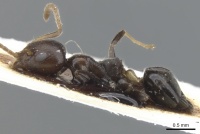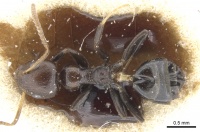Axinidris ghanensis
| Axinidris ghanensis | |
|---|---|

| |
| Scientific classification | |
| Kingdom: | Animalia |
| Phylum: | Arthropoda |
| Class: | Insecta |
| Order: | Hymenoptera |
| Family: | Formicidae |
| Subfamily: | Dolichoderinae |
| Genus: | Axinidris |
| Species: | A. ghanensis |
| Binomial name | |
| Axinidris ghanensis Shattuck, 1991 | |
This species is known only from two collections. Nothing is known of its biology, although it is assumed to be arboreal.
Identification
Snelling (2007) - Antennal scape without and pronotum with erect hairs; medial carina present and subacute in profile; distance between spines less than PPW; gastral tergum 2 shiny and sparsely punctate. The most similar species is Axinidris luhya.
Shattuck (1991) - A. ghanensis is similar to Axinidris murielae in sculpturing, head pilosity, the configuration of the propodeal spines and medial carina, and body colour, but differs in lacking erect or suberect hairs on the antennal scapes and in having fewer erect hairs on the pronotum and gastric tergites. It occurs sympatrically with, and is larger than, Axinidris murielae in Ghana. It is approximately the same size as Axinidris murielae from Cameroun.
Keys including this Species
Distribution
Distribution based on Regional Taxon Lists
Afrotropical Region: Ghana (type locality), Uganda.
Distribution based on AntMaps
Distribution based on AntWeb specimens
Check data from AntWeb
Countries Occupied
| Number of countries occupied by this species based on AntWiki Regional Taxon Lists. In general, fewer countries occupied indicates a narrower range, while more countries indicates a more widespread species. |

|
Estimated Abundance
| Relative abundance based on number of AntMaps records per species (this species within the purple bar). Fewer records (to the left) indicates a less abundant/encountered species while more records (to the right) indicates more abundant/encountered species. |

|
Biology
Species of Axinidris appear to nest exclusively within hollow plant stems, both living and dead, and in rotten wood. They are found in forested areas throughout the Afrotropical region, but are most abundant and diverse in the moist equatorial forests. Workers are primarily arboreal foragers, but may occasionally forage in ground litter.
Castes
Known only from the worker caste.
Nomenclature
The following information is derived from Barry Bolton's Online Catalogue of the Ants of the World.
- ghanensis. Axinidris ghanensis Shattuck, 1991: 114, fig. 35 (w.) GHANA.
- Status as species: Shattuck, 1994: 9; Bolton, 1995b: 77; Snelling, R.R. 2007: 560.
Unless otherwise noted the text for the remainder of this section is reported from the publication that includes the original description.
Description
Worker
(n=1). OOD 0.30, EL 0.21, HL 0.83, EW 0.10, HW 0.76, CNW 0.06, CND 0.09, SL 0.66, AL 0.98, PpW 0.34, SW 0.26, CI 0.91, CNI 1.44, REL 0.28, ScI 0.86, SpI 1.42.
Pronotum with 2 erect hairs; erect hairs on gastric tergites limited to segment 4.
Head very finely colliculate to imbricate, superimposed with large, widely spaced punctures and very weak scabriculous sculpturing; area near the mandibular insertion with a narrow band of strigulate sculpturing. Numerous erect hairs present from the occipital border to the anterior clypeal margin. Erect and suberect hairs absent from the antennal scapes. Entire pronotum and antero-dorsal region of mesonotum smooth to weakly coriarious; remainder of mesonotum and entire propodeum finely punctate; lateral areas of mesonotum more finely sculptured than propodeum. Pronotum with one pair of erect hairs. Propodeal spiracles as in A.tridens. Medial propodeal carina slightly expanded dorsally, and located posterior of a line drawn between the propodeal spiracles to just anterior of the petiolar insertion. Propodeal spines directed postero-Iaterally, with the outer surfaces concave, the distal ends narrower than the maximum width of the propodeum, and the area between them more or less flat. Erect hairs limited to gastric tergite 4. Body colour reddish brown with the propodeum darker, mandibles and antennae yellowish red, petiole reddish yellow anteriorly and translucent posteriorly, and tarsi yellow.
Type Material
Holotype worker from GHANA: Mampong (P.Room) (The Natural History Museum).
References
- Shattuck, S. O. 1991. Revision of the dolichoderine ant genus Axinidris (Hymenoptera: Formicidae). Syst. Entomol. 16: 105-120. (page 114, fig. 35 worker described)
- Snelling, R. R. 2007. A review of the arboreal Afrotropical ant genus Axinidris. Pages 551-579 in Snelling, R. R., B. L. Fisher and P. S. Ward. Advances in ant systematics (Hymenoptera: Formicidae): Homage to E.O. Wilson - 50 years of contributions. Memoirs of the American Entomological Institute, 80.
References based on Global Ant Biodiversity Informatics
- Shattuck S. O. 1991. Revision of the dolichoderine ant genus Axinidris (Hymenoptera: Formicidae). Systematic Entomology 16: 105-120.
- Shattuck S. O. 1994. Taxonomic catalog of the ant subfamilies Aneuretinae and Dolichoderinae (Hymenoptera: Formicidae). University of California Publications in Entomology 112: i-xix, 1-241.
- Snelling, R. R. 2007. A review of the arboreal Afrotropical ant genus Axinidris, pp. 551-579. In Snelling, R. R., B. L. Fisher, and P. S. Ward (eds). Advances in ant systematics (Hymenoptera: Formicidae): homage to E. O. Wilson 50 years of contributions. Memoirs of the American Entomological Institute, 80.

